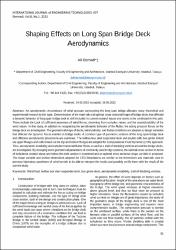Shaping Effects on Long Span Bridge Deck Aerodynamics
Özet
An aerodynamic circumstance of wind pressure surrounding the long-span bridge allocates many theoretical and
experimental research to this topic. Determination of the materials and optimal cross-sectional shape of bridge decks that affected
a dynamic behavior of long span bridge deck is still included in current research issues and works to be continued in this path.
These include the Lack of sufficient awareness of wind forces, stemming from complex nature, and the unpredictability of the
wind nature. In this study, in addition to recognizing the aerodynamic behavior of the flutter, the acting pressure forces on the
bridge deck are investigated. The geometrical shape of decks, wind velocity, and flutter conditions are adopted as design variables
that affected the dynamic forces exerted on bridge decks. A common type of geometric sections of the long-span bridge deck
and effective aerodynamic phenomena are examined. The hollow box steel suspended deck and double cells box girder linked
via upper flanges and cells linked via the top and bottom flanges are adopted for Computational Fluid Dynamic (CFD) approach.
Thus, aerodynamic instability and turbulent torsional flutter flows, as well as a trail of shedding vortices around the bridge decks,
are investigated. By changing some geometrical parameters of commonly used bridge sections, the optimal cross-section in terms
of turbulence created above and below the deck section is examined and an optimal cross-sectional shape variable is proposed.
The shape variable and section dimensions adopted for CFD-Simulations are similar to the dimensions and materials used in
previous laboratory specimens of wind tunnels to be able to interpret the results and possibly verify them with the result of the
current study.

















